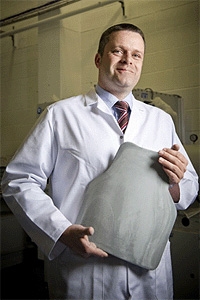Lightweight ceramic body armour is put to the test
The UK Ministry of Defence (MoD) is ballistically testing a new ceramic body armour plating that is 15–30 per cent lighter than current designs and can be made more energy-efficiently.

The plates are required by front-line troops and specialist police divisions, and are inserted into base kevlar layers with the intention of stopping high-speed rounds from armour-piercing rifles.
Dr Hywel Jones, of Sheffield Hallam University’s Materials and Engineering Research Institute, and Dr Anthony Pick, who heads a ceramic consultancy in Barnsley, have attracted £25,000 to commercialise their designs.

‘The soldier is burdened quite heavily in the field,’ said Jones. ‘Body armour itself is about 14kg just with the base and they’re always getting new kit, which actually means new weight — so if we cut down weight in other areas, then we can give them better or more kit that helps them survive and operate better in the field.’
Current armour-plate inserts are based on either alumina ceramics that typically have a density of around 3.8–3.9g/cm3 or silicon carbide ceramics that have a density of around 3.1–3.2g/cm3.
Register now to continue reading
Thanks for visiting The Engineer. You’ve now reached your monthly limit of news stories. Register for free to unlock unlimited access to all of our news coverage, as well as premium content including opinion, in-depth features and special reports.
Benefits of registering
-
In-depth insights and coverage of key emerging trends
-
Unrestricted access to special reports throughout the year
-
Daily technology news delivered straight to your inbox










Water Sector Talent Exodus Could Cripple The Sector
Maybe if things are essential for the running of a country and we want to pay a fair price we should be running these utilities on a not for profit...